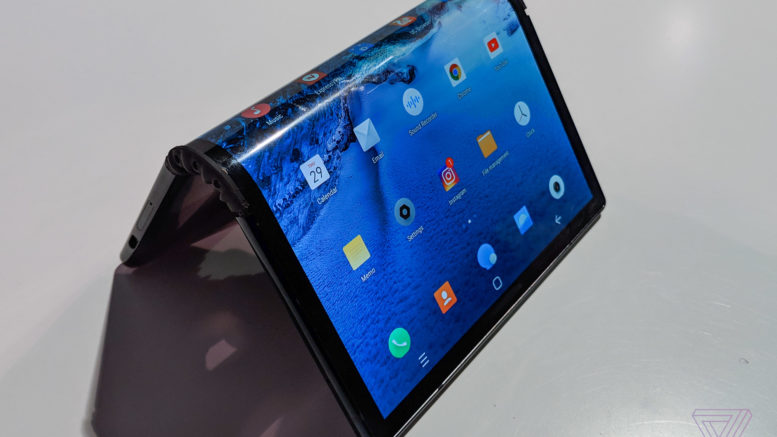Yes, there’s a foldable phone here at CES. I saw it. Kind of. It’s in the South Hall behind a lot of glass and barriers. I didn’t get close to it, could barely even see it. That’s why I chose to use someone else’s photo of it. But it’s there, and that’s interesting. Or is it?
A foldable phone?

Here’s the problem. We want a phone with a screen as large as a laptop. We want the phone to be, ideally the size of an iPhone 4. Obviously unless you break the laws of physics, that’s going to be pretty hard to do.
There have been several attempts to make something like this happen. The decade started with phones with sliding keyboards and pop-out bits, but as the “iPhone aesthetic” took hold, those went away.
For a very short time it looked like phones with built-in projectors would do the trick but those projectors were weak and blurry. Not to mention, they still sucked a lot of battery, the one thing that you can’t live without.
It was beginning to look like the only way to get more screen was to have more phone. This led to gigantic phones from major manufacturers like Samsung, and we all learned to deal with that.
And then came WestWorld

HBO’s blockbuster hit gave us a lot of tech that seemed like it was only a few years away. One of the more convincing bits was this flat trifold phone. Apparently only the size of an envelope it nonetheless folded out to become a full-featured computer with a seamless screen on the inside.
This actually turned into an immense problem for phone makers because it’s impossible to do, and yet it’s exactly what we all want. So someone had to try to do it.
Start with a flexible display

It’s actually not too hard to do a flexible display. We’ve seen them for years in curved TVs. When display panels are made,you can make them out of glass or plastic or anything that’s clear enough to let light show through. This includes the idea of transparent displays.
The only trick is to make sure the display is sturdy enough to be bent a little without breaking any of the delicate electronics. Once you’ve done that, you’re pretty much set. Of course this really applies to a display you want to bend once. When it comes to a phone, that’s a different matter.
Foldable phones
So far, every foldable phone concept I’ve seen, including the Royole FlexPal that’s on display here at the CES show, is a trainwreck of design failure. Take a trip back to phones as thick as a paperback book with giant bezels and flaky software. As far as I can see there is nothing to like – zero – about the current crop of folding phone prototypes, except that they exist. The Royole FlexPal is actually already on sale in China, a country that is much more willing to accept weird and glitchy tech in their phones. So they get points for execution. They don’t get many, but that’s still more than other companies get since no one else has brought a foldable phone to market.
It seems the problems with a foldable phone are just about what you expect. They’re not very durable, and you can’t exactly put a case on them. It’s hard to know what’s supposed to happen with the on-screen content when you fold and unfold them. And boy, are they thick. You can’t really have a nice thin phone because the flexible displays can’t bend that much. You end up with more of a trapper-keeper-esque design that’s utterly unpocketable.
At least that’s true with the current contender.
Will Samsung do any better?
Samsung’s been leaking its plans for a foldable phone for over a year. It’s going to be awesome, they say. It’s going to be like you’re in WestWorld. Except, at the moment, it doesn’t exist. Those who have seen the phone say it’s not truly durable enough to be folded completely in half. That’s sort of a dealbreaker. We want a phone that looks like a book, not like a clam. There’s another use of the word “fold” — gamblers use it when they resign from a game before it’s over. And so Samsung’s upcoming Galaxy Fold might be appropriately named after all.
Of course, there have been a lot of challenges in PC technology that seemed impossible to mount, yet they’ve all been mounted. Multitouch? Check. Super-fast networking? Check. Advanced video decoding? Check. We don’t even think about these things anymore, but at one time they were thought to be impossible in a mobile device. Someone, somewhere, may find a way to make that WestWorld phone. It probably won’t be this year, and certainly not at CES 2019.





